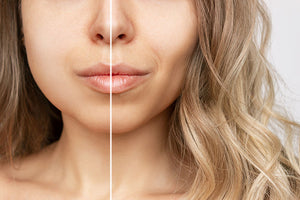Is it Time to Rethink Your Sunscreen?

TO ARTICLE LISTEN TO ARTICLE
Sunburn, brown spots, skin cancer, and wrinkles — I can list dozens of reasons why wearing sunscreen every day is absolutely necessary, whether you are indoors or outdoors. But did you know certain types of sunscreen carry both environmental and health concerns? In reality, there is a lot more to sun protection than meets the eye.
What is Sunscreen?
Sunscreens protect the skin from the sun’s ultraviolet (UV) radiation. Being considered an over the counter drug (OTC) by the Food and Drug Administration (FDA), the FDA has monitored sunscreen and its variety of ingredients since the mid-1970s to ensure all products meet the appropriate safety and effectiveness standards.
Due to its FDA classification, each bottle of sunscreen must have a Drug Facts label, which will reveal whether a sunscreen is chemical or physical (mineral).
What is "Broad Spectrum Protection" Sunscreen?
You should ideally protect your skin with broad-spectrum protection sunscreens but unfortunately, any brand can state "broad spectrum" when it truly is not, as the verity of this statement is currently not strictly monitored by the FDA. We hope this will change soon.
The key to understanding sunscreen coverage is by learning more about the active ingredients in each product, what spectrum of the UVA vs. UVB wavelengths they cover, and whether it is a chemical or physical (mineral) sunscreen.
1. Chemical Sunscreen
Chemical sunscreens contain active ingredients such as:
- Oxybenzone
- Octinoxate
- Octisalate
- Avobenzone
- Octocrylene
- Homosalate
- Mexoryl SX
Once applied, the ingredients in a chemical sunscreen absorb harmful UV rays so they cannot penetrate your skin. Each of the ingredients in a chemical sunscreen is only responsible for protecting you from a portion of the UV spectrum. Thus manufacturers will combine several chemical sunscreen ingredients to formulate a final product that gives adequate coverage. The majority of chemical sunscreens approved by the FDA have more UVB coverage than UVA, which can leave you at risk of sun damage and cancer, which is incredibly unfortunate.
The state of Hawaii was the first to ban the two chemical sunscreens oxybenzone and octinoxate, citing environmental ramifications to endangered coral reefs - which, depending on your source, is debatable. California, the Virgin Islands, and Key West, Florida have followed suit. We urge you to explore the current studies into chemical sunscreens and formulate your own opinion before making a selection.
2. Physical (Mineral) Sunscreen
Physical (mineral) sunscreens are easier to remember, as they are classified by just two active ingredients:
- Titanium dioxide
- Zinc oxide
These are the only two physical blockers currently available in sunscreens. Thus, any sunscreen label which lists additional active ingredients is likely to be a chemical sunscreen. Once applied, physical sunscreens reflect damaging UV rays away from the skin. Combined, titanium dioxide and zinc oxide have the potential to provide true broad spectrum UVA and UVB protection. However, it is important to look for the highest percentage (greater than 10% each) of these active ingredients to ensure comprehensive protection.
Historically, chemical sunscreens have been generally thinner and more transparent than mineral sunscreens. The active ingredients in mineral sunscreens are extremely white in nature, so companies have had to rework their formulas so you don't look like a pale ghost. First, brands added color to mineral sunscreens for a more tinted, natural look. Second, many brands have transitioned to smaller micronized particles for a more transparent product.
Nano-sized particles are materials measured in nanometers, or billionths of a meter, meaning the ingredient size is incredibly small. These particles create a much less opaque sunscreen, however there is controversy surrounding their safety. The Nanodermatology Society (NDS) is a reputable source for more information.
Lastly, any sunscreen approved for babies and toddlers will always be 100% physical ingredients (not nano-sized) because of the safety profile.
What do I Recommend?
There are several variables to consider when choosing a sunscreen, including active ingredients, broad spectrum protection, and the cosmetic elegance. Personally, myself and family only use mineral sunscreens since there is no controversy regarding their safety (as long as they are not nano-sized) and we are guaranteed true broad spectrum protection.
If you are in the market for a mineral sunscreen and are at high risk for developing skin cancers, consider ISDIN's Eryfotona Actinica. This novel formulation not only protects your skin from harmful UV rays but has DNA repair enzymes to prevent skin cancers. For those of you who prefer a tinted sunscreen try ISDIN's Eryfotona Ageless Sunscreen.







